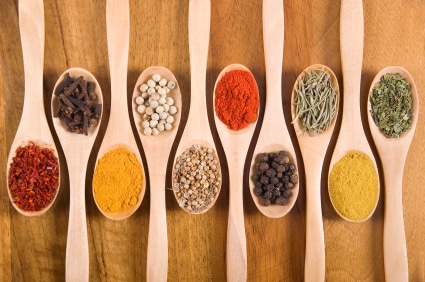
 I’m always telling clients to learn to use herbs and spices when cooking, to boost flavor and add nutrients without adding extra calories. There’s a number of special herbs that play an even more vital role in health. They’re called adaptogens. An adaptogen provides the material to help your body cope more easily with the stresses of living that can suck the energy out of it. They help boost the immune system, provide aid in keeping weight under control, improve endurance, make you feel better and even improve your mood.
I’m always telling clients to learn to use herbs and spices when cooking, to boost flavor and add nutrients without adding extra calories. There’s a number of special herbs that play an even more vital role in health. They’re called adaptogens. An adaptogen provides the material to help your body cope more easily with the stresses of living that can suck the energy out of it. They help boost the immune system, provide aid in keeping weight under control, improve endurance, make you feel better and even improve your mood.
You don’t have to take a pill or create a special mix in the lab.
Consider eating Thai food or including one of the ingredients often used in it in your diet, Tulsi—also known as Holy Basil. Holy basil isn’t like regular sweet basil found in Italian cooking. It has a taste described by some as a citrus mint and by others as peppery. It’s used in Pho and stir-fry and adding it to your diet just means adding it to dishes you might already eat. It’s been used for centuries for anxiety, diabetes, stress, colds, flu, asthma, bronchitis, headache, earache, heart disease, fever, insomnia and more. It has both anti-inflammatory an antioxidant effects on the body, which is why it’s believed to be so beneficial for a number of diseases. There’s even research being done on its cancer fighting benefits.
That yellow color could mean you’ve discovered fitness gold.
Turmeric has been boosted to the top of the herb and spice chain by the studies that show it might help Alzheimer’s. It’s the curcumin in turmeric that makes it such a powerful health aid. You can cook with it and it adds a bit of a mellow flavor to food. While I think it makes it taste richer, others don’t care for it. It took me a long time to discover that the yellow rice I saw in Asian cooking actually came from a bit of turmeric added to the mix. There are a number of health benefits attributed to turmeric, which include anti-inflammatory benefits, slower blood clotting, pain relief for arthritis, improved skin, aid for diabetics, prevention of some forms of cancer, anti-depressant, aid to reduce obesity, lower cholesterol and aid for IBS. After a tough workout, sprinkle some turmeric on your meal and it might be just what you need to reduce the aches and pains of overdoing.
Adaptogens can be mushrooms or fungi.
One of the most potent fungi for a boost in health is the Ophiocordyceps sinensis—cordycep, a fungus that originally invaded the body of a specific type of dead caterpillar found only high in the mountain regions of Tibet. It’s also called the Zombie Mushroom for a very good reason. The spores infect the larvae of ghost moths—sounding spooky already? As the larvae grows to a caterpillar, the spores munch on the insides of it, killing it in the process. It gets even spookier. The tendrils sprout out of the caterpillars head and push through the soil. If the thought of eating a zombie caterpillar isn’t for you, now supplement makers produce this fungus in the lab. It has huge benefits, such as improved metabolism, enhanced performance, boost and regulates the immune system, lowered insulin resistance, improved kidney and liver health. You can use it in Asian cooking or add it to your favorite soup.
- Rosemary is an adaptogen that contain caffeic acid and romarinic acid for heart health, better digestion and liver support. It’s also good to aid in stress relief.
- Add some maca—a root found in the Andes—to your smoothie. It has a malt like flavor and boosts energy levels, relieve stress, improve your sex drive and balance hormones.
- Licorice root is one of the adaptogens that’s found mostly in sweet and savory recipes. It promotes wellness by working with metabolic functions and is good for its anti-viral and anti-microbial benefits, plus aiding digestion and adrenal fatigue. Avoid licorice root if you have high blood pressure.
- Even if you’re just cooking with these adaptogens, always check with your physician to ensure they won’t interfere with present medications or exacerbate an ongoing condition.
